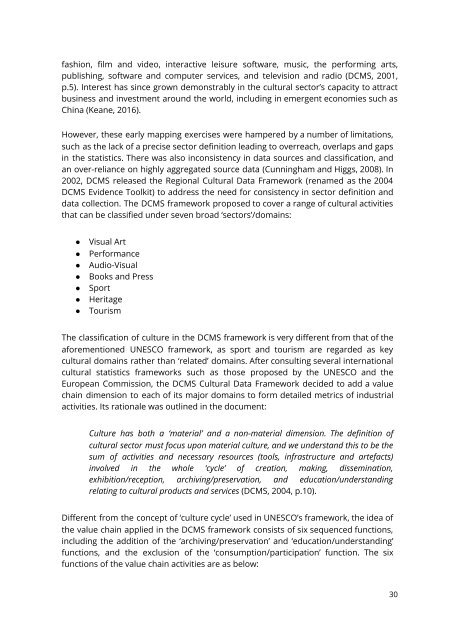MAPPING CULTURE
Mapping-Culture-Venues-and-Infrastructure-in-the-City-of-Sydney
Mapping-Culture-Venues-and-Infrastructure-in-the-City-of-Sydney
You also want an ePaper? Increase the reach of your titles
YUMPU automatically turns print PDFs into web optimized ePapers that Google loves.
fashion, film and video, interactive leisure software, music, the performing arts,<br />
publishing, software and computer services, and television and radio (DCMS, 2001,<br />
p.5). Interest has since grown demonstrably in the cultural sector’s capacity to attract<br />
business and investment around the world, including in emergent economies such as<br />
China (Keane, 2016).<br />
However, these early mapping exercises were hampered by a number of limitations,<br />
such as the lack of a precise sector definition leading to overreach, overlaps and gaps<br />
in the statistics. There was also inconsistency in data sources and classification, and<br />
an over-reliance on highly aggregated source data (Cunningham and Higgs, 2008). In<br />
2002, DCMS released the Regional Cultural Data Framework (renamed as the 2004<br />
DCMS Evidence Toolkit) to address the need for consistency in sector definition and<br />
data collection. The DCMS framework proposed to cover a range of cultural activities<br />
that can be classified under seven broad ‘sectors’/domains:<br />
●<br />
●<br />
●<br />
●<br />
●<br />
●<br />
●<br />
Visual Art<br />
Performance<br />
Audio-Visual<br />
Books and Press<br />
Sport<br />
Heritage<br />
Tourism<br />
The classification of culture in the DCMS framework is very different from that of the<br />
aforementioned UNESCO framework, as sport and tourism are regarded as key<br />
cultural domains rather than ‘related’ domains. After consulting several international<br />
cultural statistics frameworks such as those proposed by the UNESCO and the<br />
European Commission, the DCMS Cultural Data Framework decided to add a value<br />
chain dimension to each of its major domains to form detailed metrics of industrial<br />
activities. Its rationale was outlined in the document:<br />
Culture has both a ‘material’ and a non-material dimension. The de 秜ᇘ nition of<br />
cultural sector must focus upon material culture, and we understand this to be the<br />
sum of activities and necessary resources (tools, infrastructure and artefacts)<br />
involved in the whole ‘cycle’ of creation, making, dissemination,<br />
exhibition/reception, archiving/preservation, and education/understanding<br />
relating to cultural products and services (DCMS, 2004, p.10).<br />
Different from the concept of ‘culture cycle’ used in UNESCO’s framework, the idea of<br />
the value chain applied in the DCMS framework consists of six sequenced functions,<br />
including the addition of the ‘archiving/preservation’ and ‘education/understanding’<br />
functions, and the exclusion of the ‘consumption/participation’ function. The six<br />
functions of the value chain activities are as below:<br />
30



